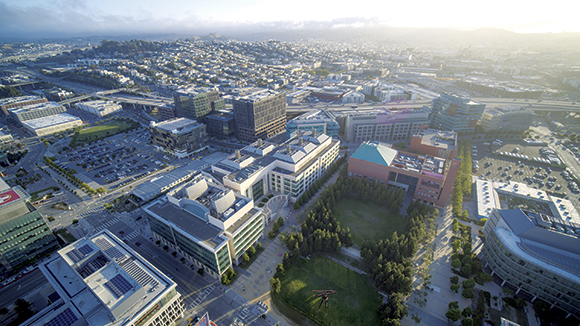BOARD OF DIRECTORS
Fall 2020 – Fall 2021
Chair
Jennifer Roth
Bimbo Bakeries USA, Inc.
Vice Chair
Scott Cameron
Sonoco
Secretary/Treasurer
Karen Shchuka
Penske Truck Leasing
Past Chair
Colleen Caravati
Corning Inc.
Matt Boehlke
Xcel Energy
Michael Connors
CORT Business Services Corp.
James Eckert
Owens Corning
Jim Hazard, SIOR
esrp
Gregory Hitchin, CEcD
City of Waynesboro
Patricia Horvatich
Pittsburgh Regional Alliance
Linda Larson
Andersen Corp.
AJ Magner
CBRE
Betsy Power
PepsiCo
Pete Quinn IV, SIOR
Colliers International
President & CEO
J. Tate Godfrey, CEcD
www.iamc.org
 The title of this column is an apt question for every forward-thinking corporate real estate executive. Being able to peer around the next corner is a talent we all need to develop to stay ahead of economic trends and the competition.
The title of this column is an apt question for every forward-thinking corporate real estate executive. Being able to peer around the next corner is a talent we all need to develop to stay ahead of economic trends and the competition.
Of course, counter to that, we all just experienced a year of uncertainty that included crisis management for the immediate, fast-paced and evolving needs of our organizations, while keeping in the forefront of our minds the health and safety of our co-workers and our very own families. Visions of the future were often blurry at times as no one really knew what to expect nor where the path would lead. So, in a very real sense, 2020 marked the first year in a very long time in which we were virtually unable to ask what the future holds.
I wish every member of IAMC could take a moment to reflect on the vastly different environments of 2020 compared to 2021 and the major difference one year can make. Undoubtedly, we were able to get a strong and totally enjoyable taste of that transition in Fort Worth — with the vibrancy, face-to-face camaraderie and networking excitement of our Spring Professional Forum.Not resting on our laurels, we pivot now to the Fall Professional Forum in Kansas City, Missouri, October 2-6. Coupled with spring’s good will and positive outlook, this year’s fall forum becomes yet another symbol of our transition to a more robust economy, one in which we can ask with a great deal of renewed confidence, “What does the future hold?” As luck would have it, that happens to be our theme for Kansas City.
It is almost guaranteed that you will find some answers to that question in each of the sessions planned for those five exciting days. On deck for fall are a wide array of topics, ranging from supply chain challenges and opportunities and the latest advancements in technology, to how to better manage the risk of environmental and capex investments.
Shark Tank’s Kevin O’Leary will also be on hand, keynoting what promises to be a fun (yes, we can have fun again!) and intriguing session on the business climate in general. And if you needed yet more proof of the forward-looking nature of the Forum, retired Navy Ph.D. Mary Kelly will deliver the closing keynote entitled, appropriately, “Master Your World: Today’s Game Plan for Maximum Profits, Peak Productivity and Top Communication.”
Of course, you can also rely on the centerpieces of all IAMC forums — the networking, the awards lunch, the new members reception and the IAMC signature sessions such as “Get Some Help!,” “Info Exchange” and peer-to-peer events for corporate and associate members alike.
The IAMC Professional Forums are designed to encapsulate the tone of the times and to provide answers to the questions those times — good and bad — create. We certainly did so last year with our virtual events. As we pivot once again to a more robust business environment, the Fall Professional Forum will encapsulate the forward-thinking nature of our business, the outlook for IAMC and its leadership and — most important — our membership. It is designed to embody the confidence and excitement with which we can now all ask: What does the future hold?
Jennifer Roth
Chair, IAMC Board of Directors
Managing the Supply Chain in the Post-Pandemic Era
by John Salustri
For IAMC members, the component of their businesses most severely impacted by the COVID-19 pandemic was arguably the supply chain. In the early weeks of the health crisis, manufacturers and distributors alike struggled to restock stores as goods — especially paper goods and personal protection equipment (PPEs) — flew off the shelves. While other commercial real estate assets — offices and hotels, for example — stood nearly vacant, plants and warehouses kept candles burning at both ends to meet the demand. That ongoing push strained global supply chains to the max and gave birth to an essential strategic question: Just in Time, or Just in Case?
 "It’s no longer just about the lowest-cost supply chain, but the
"It’s no longer just about the lowest-cost supply chain, but the
alternatives and options that are available if ‘something’ happens."
— Gregory Healy, Savills, North America
The supply chain has not normalized yet, exacerbated by the burden and the cost of transportation. In fact, Gregory Healy, executive vice president and head of Industrial for Savills, North America, puts transportation at 50%, at least, of total supply chain expenditure. “It’s not so much the real estate that drives the locational decisions,” he says, “as it is the overall transportation costs.”
He adds that inventory solutions are still being normalized by corporate strategic planners and their consultants. “There won’t be an overnight shift,” says Healy, who, from his Orange County, California, office, can see the long line of cargo ships waiting to enter the Port of Los Angeles. “It’s no longer just about the lowest-cost supply chain, but the alternatives and options that are available if ‘something’ happens. Businesses need to consider the Just in Case scenarios.”
From Predictable to Surprise Demand Shifts
But what exactly is that something? We all know the predictable events, the holiday rushes that swell distribution stocks and other knowables, such as the coming of hurricane season. And what about such disruptions as ships (container ships, no less) blocking the Suez Canal or a global, overnight economic shutdown at the hands of a pandemic?
“Sellers, wholesalers, retailers and manufacturers have all learned some important lessons during the pandemic,” explains Atlanta-based Bethany Clark, Cushman & Wakefield’s lead in the Americas for Industrial and Logistics Strategy and Client Solutions. Those lessons included “how to adjust their supply chains to better anticipate disruptions in inventory and the delivery of raw materials, all of the things they need in order to make sure they can get goods to their customers and consumers.” Some can pivot toward that sort of adjustability very quickly, she says, but “the reality of some sectors is that they need to step back and reconsider all of the upstream implications of potential disruptions of their supply chains.”
The experts we spoke with currently see an overall increase in businesses increasing their safety stock. Healy believes that the 20% increase that is typically thrown around is indeed “fairly accurate, but it will vary across companies and verticals. It’s better to take the incremental increase of carrying the inventory than to not have it at all. With the challenges of getting goods into the U.S. right now, it’s better to say if I can get it, I’ll take it right now.”
Solutions, Old and New
It should be noted here that automation systems — the growth of which was well on its way prior to 2020 — can help make delivery more efficient. “There’s been an increase in conversations around upgraded systems and hardware since the pandemic,” says Clark. “There’s been a clear acceleration and amplification of strategies that were already in play.”
But here too, challenges exist. Healy says it’s a question of which horse you back. Automation upgrades can be a heavy investment, and the industry is changing so fast that next year, the market might have something that will increase productivity and efficiency not by the 20% of your latest investment but by 30%.
“You always have to consider the capex in relation to the ROI of the automation investment,” he says. “Flexibility is key.”
 "The reality of some sectors is that they need to step back and reconsider all of the upstream implications of potential disruptions of their supply chains."
"The reality of some sectors is that they need to step back and reconsider all of the upstream implications of potential disruptions of their supply chains."
— Bethany Clark, Cushman & Wakefield
Now the Big Question: JIC or JIT?
Which brings us to the question of Just in Case inventory as a replacement for the Just in Time strategies that have pretty well dominated the market for the past 25 years. “There’s always pressure to decrease the cost of inventory,” says Healy. “Just in Time responds to that pressure by spoon-feeding the supply chain. But it also creates an environment of scarcity, so you’re dependent upon the next shipment coming in on time” and, he adds, with such disruptions as the Suez Canal blockage, “a significant disruption causes a domino effect, requiring the rerouting of shipments.” (See sidebar.)
“Just in Time isn’t obsolete yet,” says Clark. “It still has its benefits. People will figure out for their sectors and operating margins what’s the right balance of Just in Time and Just in Case.” On the whole, she adds, inventory-to-sales ratios are relatively low right now, due in large part to the overhanging supply chain delays mentioned previously. Simultaneously, as we swing into prep time for the holiday season, stocking levels will very shortly need to beef up. Ultimately, there will need to be more fine-tuning between the two strategies that addresses both seasonal bumps and the possibility of unanticipated demand.
“We have to be more comprehensive about what-if scenarios in the creation or re-creation of a supply chain strategy,” says Healy.
It might also mean being a bit more creative in the route our products take . . . not from our warehouses, but to them. But once again, it won’t happen overnight, he says. “Global supply chains are complex, so creating the proper balance of Just in Time and Just in Case will continue to evolve gradually and continuously, as different risks appear.”
